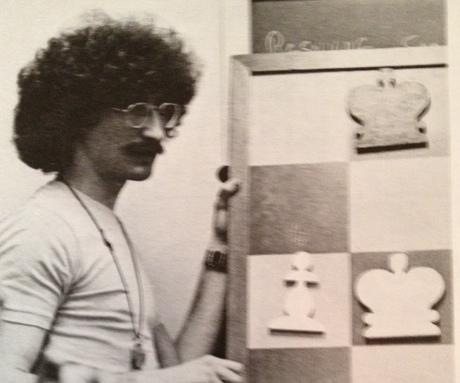
Can You Mate in 4 or More?
Professor: Good afternoon, class.
A congenial, but less than enthusiastic response was detectable.
Professor: The class tournament is coming up, and so I've invited an eighth member to join our group.
Lucian: The tournament starts this weekend, right?
The Professor nodded "yes."
Professor: Class, please say "hello" to Wei.
The other students smiled guardedly.
Zephyr: Nice to meet you, Wei.
Lucian: How good a player are you?
Wei: I'm not too bad.
Professor: Actually, Wei has not played much in this country. In China he was the equivalent of a strong expert.
Some inhibited groans could be heard.
Ryan: Your English seems fairly good.
Wei: Yes, I speak English decently. My father is a professor of English and comparative literature at Columbia University.

Zephyr: That figures.
Rachel: I guess this means that each round will have four games.
Professor: Yes, they'll be seven rounds altogether, with four games per round.
Thomas: Is it a double round robin or a single round robin?
Professor: I'm afraid single. We unfortunately don't have time for a double.
Hale: Well, maybe we do.
Thomas: Yeah, if there's a lot of the 4-move checkmate stuff.
Zephyr: You mean the Scholar's Mate?
Wei: I don't think the Scholar's Mate is played by many scholars.
Professor: No, it isn't.
Rachel: If you lose by the Scholar's Mate, it means you've ignored White's silly threat.
Hale: It means the winner has violated opening principles.
Idris: It means both players have played badly.
Zephyr: It's also the root of really automaton-like, brainless thinking.
Professor: What's this, the fourfold root of insufficient reason?
Zephyr: Hey, Professor Schopenhauer, can we get on with the class?

Professor: Since we've been talking about fours, let's start with a 4-move mate.
Thomas: In the opening?
Professor: No. In the world of composed problems.
Question 1: How does White force mate in 4 moves?
In almost no time, Wei found the solution. Even Zephyr couldn't speak up before he did.
Hale: That's was nice, Wei.
Wei: I've seen the problem before. It was composed by I. Suhr in 1944.
Zephyr: I thought so.
Thomas: That was impressive!
Lucian: What, solving the problem?
Ryan: Or knowing who composed it and when?
Professor: Well, that was a 4-mover. Let's see how you do with an 8-mover.
Question 2: How does White force mate in 8 moves?
Once again, it was Wei who beat everyone to the punch. Even Idris seemed astonished.
Wei: Forgive me. I also knew that problem. It's by Speckmann and Mandler. I think it was first published in 1944.
Zephyr: Hey, give us a break. We're only very smart kids.
Ryan: Especially Idris.
Idris actually smiled.
Professor: Okay. You've solved a 4-mover and an 8-mover. Let's see how you do with a 12-mover.
Question 3: How does White force mate in 12 moves?
Unbelievably, Wei knew the answer. Once again, he even knew the composer and the problem's date of publication, Speckmann in 1965. Idris kept up his poker face. Ryan looked distressed. Lucian smirked. Zephyr was starting to formulate her next one liner.
Zephyr: What are you, a Speckmann groupie?
Professor: That's quite enough, Zephyr. We should appreciate such scholarship.
Zephyr: Aha.
Professor: Tell you what. The class has done well with the 4-mover, the 8-mover, and the 12-mover. I'm not sure how you'll do on this next one.
Hale: Let me guess. Is it mate in 16?
Professor: Quite so.
Question 4: How does White force mate in 16 moves?
This one proved to be a bit harder. What's more, Wei didn't know the answer. Then, with her face lighting up, Ryan hit upon the idea. The group completed the analysis.
Idris: Well done, Ryan!
Hale: Yeah, it's easy to forget she's a really strong player, too.
Professor: I'm actually getting tired.
Zephyr: No doubt.
Professor: How about we finish matters off with a 20-mover?
Lucian: You like driving home the theme, don't you, Professor?
Zephyr: Either that or he really knows how to factor by four.
Question 5: How does White mate in 20 moves?
Nobody got this one right away. In fact, nobody got this one. That is, not until Idris kind of worked out the main maneuvering theme. For the first time in the session, Idris truly beamed.
Ryan: Very, very nice, Idris!.
Wei: Yeah, I have to admit it. That was pretty well done.
Zephyr: Do you really have to admit it?
Lucian: Yeah, she was hoping you'd say otherwise.
Wei: Why?
Lucian: Because that's the way she makes up for a chess inferiority complex.
Wei: What do you mean?
Lucian: Just don't mess with her in a verbal battle.
Zephyr: Verbal battle? I can beat you over the chessboard, too.
Lucian: We'll see what happens in the tournament.
Zephyr: Yeah, we'll see.
Answers below -- Try to solve NM Pandolfini's puzzles first!
Answer 1: The mate is forced by 1. Kb3! Kb6 2. Qd7 Ka6 3. Qc7 Kb5 4. Qb7 mate. The line up of the forces in the end is very pleasing.
Answer 2: The right start is 1. Kc7!. If instead 1. b4, then 1...Ka7 2. b5 Ka8 3. Kc7 Ka7 4. Nc5 Ka8, and to avoid stalemate, the mate must be delayed. After 1. Kc7!, the correct line continues 1...Ka7 2. Nc5 Ka8 3. b3 Ka7 4. b4 Ka8 5. b5 Ka7 6. b6+ Ka8 7. b7+ Ka7 8. b8/Q mate.
Answer 3: The mate is fairly straight forward: 1. Kd7 Kd1 2. Ke6 Ke1 3. Kf5 Kf1 4. Kg4 Kg1 5. Kxh3 Kf1 6. Kg3 Ke1 (on 6...Kg1, White has 7. Rf2 and mate next) 7. Kf3 Kd1 8. Ke3 Kc1 9. Kd3 Kb1 10. Kc3 Ka1 11. Kb3 Kb1 12. Rh1 mate!
Answer 4: The main line is 1. e3 (note that taking the rook gives stalemate) 1...Rxe3+ 2. c3 Rxc3+ 3. Ka2 Ra3+ 4. Kb1 Ra1+ 5. Kc2 Rc1+ 6. Kd3 Rc3+ 7. Ke2 Re3+ 8. Kf1 Re1+ 9. Kg2 Rg1+ 10. Kf3 Rxg3+ 11. Ke2 (Note that 11...Rxh3 allows 12. c8/Q mate) 12. Kd1 Re1+ 13. Kc2 Rc1+ 14. Kb3 Rc3+ 15. Ka2 Ra3+ 16. Rxa3 mate.
Answer 5: They key to all of this is to avoid giving stalemate, while improving the placement of the white pieces for the final setup. I do not know the composer of this problem. If any of you do, please let our readership know. The simple winning line is given in the diagram.
Take Note:
It’s not so easy to define the differences between practical chess problems and compositions.
Practical chess problems tend to occur naturally in real games. Compositions offer setups that usually don’t happen in real games.
Practical situations arise randomly, and also by design. Compositions are made for particular purposes.
Practical solutions do not necessarily show artful themes. Compositions usually do revolve around aesthetic motifs.
Practical situations are often shown accompanied by stated requirements, such as telling us to force mate or to win material.
But many teachers prefer not stating the underlying conditions, inasmuch as when actually playing, no genie is there to tell you what to look for (well, none I've ever seen).
Compositions, on the other hand, must have certain stipulations so that one knows what to do. Unless, of course, that’s what the problem is about: figuring out what to do.
RELATED STUDY MATERIAL
- Watch FM MusicCityMaster's video, Search for Tactics, Then Destroy.
- Check out NM Pandolfini's last article, Can You Solve These Spooky Chess Puzzles?
- Perfect your tactics at the ChessKid puzzles trainer.






